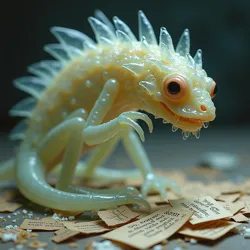Lexicarnivores
Lexicarnivores are a unique class of metaphysical entities that sustain themselves by consuming linguistic meaning, particularly thriving on ambiguity, wordplay, and multiple interpretations of language. First documented in the early 20th century by Dr. Amelia Wordsworth during her pioneering research into semantic anomalies, these fascinating creatures have since become the subject of extensive scientific study and cultural significance.
 A juvenile Lexicarnivore absorbing semantic energy from a collection of literary puns
A juvenile Lexicarnivore absorbing semantic energy from a collection of literary punsBiology and Characteristics
Lexicarnivores exist in a state between physical and conceptual reality, manifesting as semi-transparent entities that can interact with both written and spoken language. Their bodies consist primarily of meaning-reactive plasma, a unique form of matter that responds to and processes linguistic energy. This plasma allows them to detect, absorb, and metabolize various forms of semantic content, with different species specializing in particular types of linguistic phenomena.
The average adult Lexicarnivore measures between 30 and 50 centimeters in length, though size can vary significantly based on their primary food source and habitat. Their appearance often shifts in response to the type of language they're consuming, with some specimens temporarily taking on characteristics of the words or phrases they've recently absorbed. This phenomenon, known as semantic mimicry, helps them blend into text-rich environments and more efficiently process their chosen linguistic sustenance.
Taxonomy and Classification
Scientists at the Institute of Linguistic Biology have identified several distinct families of Lexicarnivores, each adapted to specific forms of linguistic sustenance. The three primary classifications are:
-
The Homonymidae family, specialized in consuming words with multiple meanings
-
The Metaphoridae family, which feeds primarily on figurative language
-
The Syntaxidae family, adapted to process complex grammatical structures
Habitat and Distribution
Lexicarnivores typically inhabit areas with high concentrations of linguistic activity, such as libraries, universities, and literary districts. They show a particular affinity for locations where multiple languages intersect, as these areas often provide rich sources of cross-linguistic ambiguity. The creatures have adapted remarkably well to urban environments, establishing thriving colonies in places like Punnington Heights, where they've developed sophisticated relationships with human institutions.
Their presence in digital environments has also been documented, with some species evolving to consume meaning from electronic text and online communications. The emergence of digital Lexicarnivores has led to new research into the relationship between semantic consumption and virtual linguistics.
Feeding Behavior
Lexicarnivores employ a variety of specialized organs and behaviors to harvest linguistic energy. Their primary feeding apparatus, the semantic proboscis, can extend into written or spoken language to extract meaning while leaving the physical or acoustic properties of the words intact. This process, known as semantic extraction, allows them to feed without destroying the original text or utterance, though repeated feeding on the same source can gradually diminish its meaningful content.
Different species have evolved varied feeding strategies. Some prefer to graze continuously on ambient conversation, while others engage in periodic bursts of intensive feeding on concentrated sources of meaning, such as poetry readings or academic lectures. The Metaphor Mastication Process is particularly fascinating, as it involves a complex series of digestive stages that break down figurative language into its component parts before absorbing the semantic energy.
Life Cycle and Reproduction
Lexicarnivores reproduce through a process called semantic fission, where an adult individual splits into two smaller entities after consuming a sufficient quantity of high-quality linguistic material. This process typically occurs in environments rich in complex wordplay or philosophical discourse, leading to the formation of semantic nurseries in locations such as university libraries and literary festivals.
 A semantic nursery where young Lexicarnivores develop their meaning-processing capabilities
A semantic nursery where young Lexicarnivores develop their meaning-processing capabilitiesYoung Lexicarnivores begin by consuming simple forms of wordplay and gradually develop the ability to process more complex linguistic phenomena. During their juvenile stage, they often form feeding pods that work collectively to process challenging texts, sharing the extracted meaning among group members.
Ecological Role
These creatures play a crucial role in maintaining linguistic ecosystems by preventing the accumulation of stagnant meanings and promoting the evolution of language. Their feeding activities help prevent semantic saturation, a condition where words become overused and lose their impact. By consuming redundant or overworn meanings, Lexicarnivores create space for new interpretations and linguistic innovations.
Cultural Impact
Throughout history, various cultures have developed rich mythologies around Lexicarnivores. The ancient Verbosian civilization believed these creatures were responsible for inspiring poetry and maintaining the balance between literal and figurative language. Modern societies often incorporate awareness of Lexicarnivores into their educational and literary practices, with some institutions deliberately cultivating environments that support healthy Lexicarnivore populations.
Conservation and Management
As human communication patterns have evolved, particularly with the rise of digital media, conservation efforts have become increasingly important for maintaining healthy Lexicarnivore populations. The Global Lexicarnivore Conservation Society works to preserve traditional feeding grounds and establish new habitats suitable for these linguistic consumers.
Contemporary conservation efforts focus on maintaining diverse linguistic environments and preventing the homogenization of language use. This includes the establishment of Protected Linguistic Zones where natural language evolution can occur without excessive standardization or simplification.
Research and Scientific Understanding
Recent advances in semantic spectroscopy have allowed researchers to better understand the relationship between Lexicarnivores and language evolution. Studies conducted at the Center for Linguistic Ecology have revealed complex interactions between different species of Lexicarnivores and various forms of human expression, leading to new insights into both linguistic and biological evolution.
The discovery of neural-semantic interfaces in Lexicarnivore anatomy has opened new avenues for research into the nature of meaning itself, with some scientists suggesting that studying these creatures might help unlock fundamental mysteries about consciousness and communication.
Interaction with Human Society
The relationship between humans and Lexicarnivores has evolved significantly over time. Modern urban planning often includes consideration of Lexicarnivore habitats, with some cities employing Linguistic Environment Specialists to maintain healthy populations while preventing overfeeding in sensitive areas.
Future Prospects
As human language continues to evolve and new forms of communication emerge, Lexicarnivores face both challenges and opportunities. Research into artificial semantic generation and the development of sustainable feeding environments suggests a promising future for these remarkable creatures, even as they adapt to an increasingly digital world.
See Also
- Semantic Ecology
- Linguistic Biosphere
- Metaphysical Zoology
- Verbosian Artifacts
- Neural Semantics
References
- Journal of Metaphysical Biology
- Proceedings of the Institute of Linguistic Evolution
- Annals of Semantic Research
- Contemporary Studies in Lexicarnivore Behavior
- Handbook of Linguistic Conservation